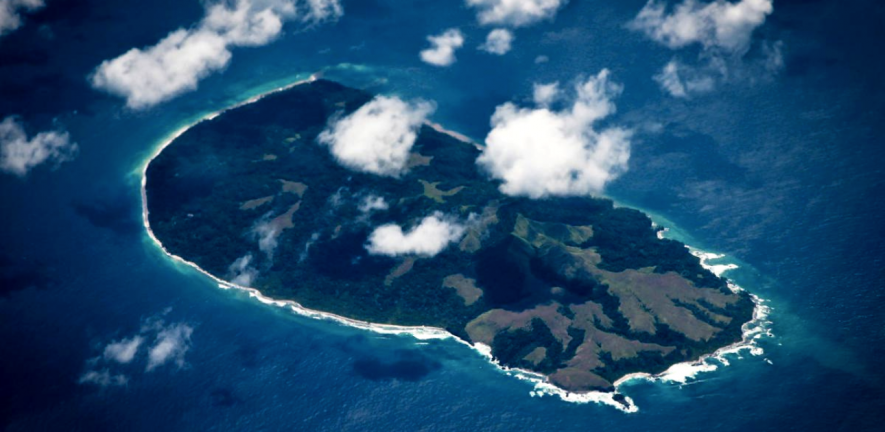Why NGT’s Recent Ruling on Pleas Against Green Nods to Great Nicobar Islands Project is Flawed

What is the development project in question, and why was it challenged before the NGT?
EVER heard of the Andaman and Nicobar Islands Integrated Development Corporation? This is the latest kid on the development block. With the globe in the throes of climate change— and our country having greenhouse gas reduction commitments— the corporation has proposed an economic project on the graveyard of 131 sq. km of prime forest on the Great Nicobar Island (GNI).
The GNI project of the corporation proposes an international container transhipment terminal, a greenfield international airport, a 450 MVA gas- and solar-based power plant, and a township stretching over 16,610 hectares. These are all designed to promote “not only the economic development of the island and surrounding areas of strategic location but also for defence and national security.”
Despite the fact that these lands form the habitat of two tribal communities protected by a number of excellent pro-tribal laws, the project received Stage-I Clearance under the Forest (Conservation) Act, 1980 on October 27, 2022 for diversion of the forest land, and two environmental clearances (ECs) from the Union Ministry of Environment, Forest and Climate Change (MoEF&CC), the first on November 4, 2022 and the second on November 11, 2022. Both ECs are absolutely similar in content.
The NGT proceeded to pronounce summary judgment on all four appeals though not a word had been argued by one of the appellants. It passed its judgment in violation of the principles of natural justice.
Four appeals were filed at the National Green Tribunal’s (NGT) Eastern Zone Bench in Kolkata, against the clearances for the GNI project— three by the Mumbai-based non-profit organisation Conservation Action Trust (CAT) challenging both the forest clearance (FC) as well as the ECs, and one by environmentalist Ashish Kothari, which challenged one of the two ECs.
A six-member ‘special Bench’ of the NGT gave the project the ‘green’ signal on April 3. But under what circumstances?
Why were the NGT proceedings in violation of natural justice principles to begin with?
Notices on these four appeals had been issued in January this year by the NGT’s Kolkata Eastern Zone Bench. On April 3, the four appeals were listed on the cause list of the Eastern Zone Bench under the heading ‘For Filing of Affidavits’. This category is quite distinct from the matters listed ‘For Final Hearing’. However, quite surprisingly, a ‘special Bench’ of six members was constituted for the day, comprising four judicial members and two experts (largely from the northern zone Bench, New Delhi) to hear the matters.
Despite what the cause list for the day stated, the special Bench insisted that it would finally hear and dispose of the GNI project appeals that day itself.
I was informed that the advocate-on-record (AOR) for CAT pleaded that the organisation had engaged a senior counsel to argue the matter, who was not present in the court since the appeals were only listed for completion of pleadings. The AOR also urged that he himself was neither briefed nor instructed to argue the matter and sought a fixed date for the final hearing. To no avail. His request for short adjournment was turned down (so much for natural justice), and it was left to the counsel for Kothari to argue his appeal, which he perforce did, restricting his arguments to the challenge to only the EC.
The NGT proceeded to pronounce summary judgment on all four appeals, including the forest appeal, though not a word had been argued by one of the appellants. It passed its judgment, once again, in violation of the principles of natural justice. Alas, this has become the norm as far as the NGT is concerned.
It would not be out of place to point out that the constitution of a six-judge Bench is itself in total disregard of the provisions of the NGT Act, which prescribes that the judicial officials and experts must be equal in number. It is also not clear why a Bench of six members from outside the Eastern Zone Bench had to be constituted when there was an existing Bench in Kolkata to hear these matters.
This is not the first time that the NGT is acting contrary to its mandate and in disregard of law. When the NGT’s Pune Bench fell short of its minimum prescribed members after one of them retired, instead of making effort to find a replacement expert member, the chairman directed that matters of the Western Zone Bench be taken up by the Northern Zone Bench (also self-termed as the principal Bench) headed by him. Even though one thought this to be an interim measure, it continued even after the Western Zone Bench was reconstituted.
Faced with the challenge to this practice from a Goa-based NGO, a full Bench of the Bombay High Court at Goa reprimanded the NGT in 2020 and directed that matters emanating from the territorial limits assigned to the Western Zone Bench could not be transferred to the Northern Zone or any other zone. The NGT challenged the order, but was told by the Supreme Court last month, in no uncertain terms, that all NGT Benches were equal to each other and that the Northern Zone Bench could not appropriate matters from the Western Zone to itself.
The constitution of a six-judge Bench is itself in total disregard of the provisions of the NGT Act, which prescribes that the judicial officials and experts must be equal in number. It is also not clear why a Bench of six members from outside the Eastern Zone Bench had to be constituted when there was an existing Bench in Kolkata to hear these matters.
Would a hearing of the GNI project matter by an improperly constituted special Bench, composed of members from the Northern Zone Bench, hearing an Eastern Zone matter, not amount to contempt of the Supreme Court’s explicit directions on this very issue?
How did the NGT decide the matter?
But keeping that matter aside for the moment, what sort of a judgment did the NGT finally pass on the four appeals?
The actual judgment is 64 pages long. It records that, “While the tribunal’s consideration is confined to materials on record, we have also noted (without any comment) media reports that the area is located in China’s ‘string of pearls’ strategy which is sought to be countered by Indian authorities under India’s ‘Act East’ policy— the Indian Ocean having emerged as a key intersection zone of Indian and Chinese strategic interests.” The judgment also observes that there are media reports of huge poaching of environmental marine resources of the Andaman (corals, sharks, fishes) by poachers from Myanmar and other countries. (These media reports were not shared with the appellants.)
But, in the end, it is the economic considerations in terms of the potential for international trade and transshipment cargo which apparently persuaded the members of the tribunal to assure themselves that “by and large, the project is compliant [with the mandatory environment laws]” and it is not necessary to interfere with the clearances granted.
The significant challenges to the FC as set out by the CAT were the following:
- That there would be a severe impact of the diversion of 130.75 sq. km of pristine tropical rainforests on the biodiversity of the region and the wildlife habitats
- That prime forest land cannot be diverted for township and non-site specific projects
- Further, not only were the mandatory provisions of the Scheduled Tribes and Other Traditional Forest Dwellers (Recognition of Forest Rights) Act, 2006not followed, but the settlements of the Shompen (classified as a Particularly Vulnerable Tribal Group) and the Nicobarese (a Scheduled Tribe)— the forest and coastal dwelling communities on the island— would have to be diverted and denotified.
The tribunal dealt with the challenge as follows: “It is seen that the forest cover in the area is more than 75 percent. While the forest is of great significance in tackling air pollution and climate change, development cannot be totally ignored. There is hardly any development in the area. There is a need not only for economic development but also national security. There is no conflict of interest as such… There is a policy permitting afforestation outside the state if forest cover is more than 75 percent. Thus, no case is made out to interfere with the FC.”
The judgment refused to get into the nitty gritty of the issues raised by the appellants. Instead, the NGT dealt with the appellants’ objections by relying on the various reports and studies that had formed the basis for the EIA report and the EC.
The challenge to the EC raised several substantial issues, including the charges that:
- The appraisal conducted by the ‘expert appraisal committee’ (EAC) was not in accordance with the Environmental Impact Assessment (EIA) notification
- The EIA report has not been prepared as per the terms of reference (ToRs)
- The public hearing was vitiated
- The impact of the project on the tribal population had not been considered
- There was no cumulative impact assessment done
- The Island Coastal Regulation Zone (ICRZ) Notification, 2019had been violated.
Also read: Proposed amendments to the CRZ Notification, 2019 and its implications
The appellants also laid stress on the fact that both the EAC and the MoEF&CC had completely ignored the precautionary principle in their assessments, more so as some of the studies were only preliminary reckonings and full-fledged ones were still awaited. It was therefore alleged that the project would result in the destruction of forests, turtle nesting grounds, the habitat of endangered endemic species and the violation of the rights of indigenous communities in the GNI.
The judgment refused to get into the nitty gritty of these issues raised by the appellants. Instead, the NGT dealt with the objections by relying on the various reports and studies that had formed the basis for the EIA report and the EC. Is this what a tribunal is meant for?
For instance, in the case of the impending threat to leatherback turtles, the judgment simply refers to the Wildlife Institute of India’s (WII) plan that has been prepared for conservation and long-term monitoring of sea turtles of the Nicobar Islands— along with leatherback sea turtles— for a period of ten years. Phase 1 involves tracking their movements, breeding patterns, foraging areas, nesting, and so on, while Phase 2 of the conservation plan promises to develop effective site-specific actions for conservation of sea turtles. There is also a proposal submitted by the WII and the Andaman and Nicobar State Forest Department towards addressing the issue of saltwater crocodile conservation and conflict mitigation. But these are mostly in the air.
Similarly, for ensuring movement of wildlife between the forest and the sea coast for animals, including reptiles, the judgment is satisfied that safe wildlife corridors ranging from 250 meters to 1,100 meters have been selected based on inputs provided by the Zoological Survey of India (ZSI), and the Andaman and Nicobar administration’s Department of Environment and Forest.
The judgment refers to a ‘mangrove conservation and management plan’ for GNI prepared by the Department of Environment and Forests, which is aimed at the restoration and restocking of tsunami-impacted mangrove areas, and a ‘coral conservation plan’ prepared by the ZSI. The judgment finds it noteworthy that there are huge budgets proposed for each. For example, ZSI’s plan for coral translocation has a budget of ₹55 crore.
The EC lists numerous conditions subject to which the project will be executed— these conditions are too numerous to mention and they cover all aspects of the projects— but most often, these are only for the record and will remain restricted to the paper they are printed on, as once the project gets going, it will be difficult to turn the clock back. Many of the conditions are also contrary to others listed in the same clearance.
The appellant’s principal challenge to the ECs— on the grounds that the precautionary principle was ignored by both the EAC and the MoEF&CC— was also squarely ignored by the NGT. This, despite the appellant pointing out that the studies done so far were sketchy and incomplete, and that the researchers, totally unfamiliar with the islands and their ecology, had not even bothered to collect data from an entire cycle of seasons.
For instance, while on the one hand, the EC states that no dusty cargo or dry bulk cargo such as coal, iron ore or hazardous cargo, among other things, would be handled at port, it also permits the transport of hazardous cargo if it is in containers, which will be handled in accordance with the Manufacture, Storage and Import of Hazardous Chemicals Rules, 1989. These containers would be stored at separate locations in the yard designated for the storage of hazardous cargo, and a dedicated nodal officer would be appointed who would be responsible to check the compliance of the regulations from time to time.
The EC announces that the project activities shall not disturb the Shompen tribe and their habitations. Clear demarcation of the land shall be done in the vicinity of the project area, such that the tribal habitations shall not be affected. However, for their protection, safety and security, a surveillance mechanism shall be installed with geo-fencing-cum-surveillance towers near the tribal settlements. In other words, the tribal populations would be prisoners in their own domain.
The appellants’ challenge that the consideration of sea-level rise has not been kept in mind, particularly as the area is a part of a seismic zone-V, having the potential for disasters, is simply answered by the tribunal accepting the MoEF&CC’s stand that proper appraisal has been conducted by the EAC in its meetings.
It is emphasised that the EAC comprised not only members of Infra-I sector; but also member secretaries of the Infra-II sector; the thermal sector; the coastal regulation zone (CRZ) sector; and the nuclear, defence and strategic sector for comprehensive appraisal of the various components of the project, both before grant of the ToR and thereafter at the time of appraisal for grant of the EC/CRZ clearance. In other words, if all these experts put together have not found serious problems with the project or they have concluded that the advantages outweigh the risks, why would the NGT not weigh in favour of these reports by the experts?
Also read: A seat at the table: public participation in the environmental decision-making process in India
The MoEF&CC further emphasised that the project proponent was awarded detailed ToRs— 18 specific ToRs for the international container transshipment terminal, 23 specific ToRs for the airport, 12 specific ToRs for the township and area development project, and 52 specific ToRs for the gas- and solar-based power plant, in addition to special conditions and all standard ToR conditions as applicable to such projects. Moreover, a public hearing was held involving 138 participants on January 27, 2022. The project was deliberated upon at more than three meetings of the EAC, before the environmental clearance was finally accorded on November 4, 2022.
Relying on a handful of judgments which emphasise the need for striking a balance between the ecology and environment on one hand and the projects of public utility on the other, the NGT chose to endorse the view that if a project is beneficial for the larger public, inconvenience to a smaller number of people is to be accepted, even though the tribunal is compelled to admit that this is not a case of “some inconvenience” only.
Why is the NGT’s judgment flawed?
It appears quite clear that despite recognising that grave and irreversible injustice would be caused to the ecosystem— the habitats of birds and reptiles, the corals and the mangroves, the forests and a host of other species— not forgetting the tribal people who have lived in harmony with nature on these islands for centuries and who are now to be forced out of their homelands and sought to be relocated elsewhere— the NGT simply refused to examine on merits the case made out by the appellants. It did this by restricting the examination of the appeals to whether requisite procedures had been followed or not.
About 131 sq. km of pristine forest, created by nature for a purpose, would be sacrificed, simply because we are incapable of understanding why nature created the GNI and its biodiversity. But a more troubling reason is also obvious: the present generation has absolutely no qualms in compromising the prospects of the next generation.
Such superficial examination of challenges to environment clearances makes a mockery of the constitution of the NGT itself as an expert body, half of whose members must necessarily be experts in the fields of forestry or the coastal regime or air and water pollution, among other things. The experts are there for a purpose. If they serve no purpose, the NGT is an empty shell of environmental jurisprudence and a mockery of the environmental rule of law.
The appellant’s principal challenge to the ECs— on the grounds that the precautionary principle was ignored by both the EAC and the MoEF&CC— was also squarely ignored by the NGT. This, despite the appellant pointing out that the studies done so far were sketchy and incomplete, and that the researchers, totally unfamiliar with the islands and their ecology, had not even bothered to collect data from an entire cycle of seasons. This would have given a clearer picture of the harmonious setting that the project would disrupt from its inception and would have enabled a credible cost–benefit analysis. Instead, the challenge was met with the stock argument that further studies would be undertaken, as found necessary from time to time.
It is perhaps for this reason that after expressing satisfaction that “[i]n the present case, laid down procedure has been followed, public hearing held, EIA prepared, EAC evaluation undertaken, wildlife habitats protection [and] tribal welfare considered, and necessary conservation measures planned”, the NGT nevertheless decided to constitute a high-powered committee (HPC) headed by the MoEF&CC secretary to revisit the EC and examine the unanswered deficiencies pointed out by the appellants, including the survival of the coral colonies, the violation of the ICRZ Regulations, and the location of the port in CRZ-IA areas (that is, those areas that are ecologically sensitive).
It directed the HPC to finalise its proceedings within two months, after which the EC or its conditions may be looked into in light of the HPC report. It then effectively stayed the project for those two months: “Till then, further work in pursuance of [the] impugned EC may not proceed except for the work which may not be of irreversible nature.”
How does the NGT judgment violate a 2019 Supreme Court ruling on the grant of EC?
In declaring the “environmental rule of law” in the Mopa airport case (based in Goa) in 2019, the Supreme Court came down heavily on the authorities for failing to ensure adequate environmental studies related to impacts of the project. The NGT, it appears, would have benefitted from a close reading of that crystal-clear Supreme Court judgment on a greenfield airport proposed on a mere 2,271 acres. The GNI project, in contrast, it is reiterated, will be 131 sq. km!
In its Mopa judgment, the Supreme Court made the following observations about the manner in which the EC had been recommended for the airport project:
“The role of the decision makers entrusted with authority over the EIA process is to ensure that every important facet of the environment is adequately studied and that the impact of the proposed activity is carefully assessed. This assessment is integral to the project design because it is on that basis that a considered decision can be arrived at as to whether necessary steps to mitigate adverse consequences to the environment can be strengthened.
“In the present case, as our analysis has indicated, there has been a failure of due process commencing from the non-disclosure of vital information by the project proponent in Form 1. Disclosures in Form 1 are the underpinning for the preparation of the ToR. The EIA report, based on incomplete information, has suffered from deficiencies which have been noticed in the earlier part of this judgment including the failure to acknowledge that within the study area contemplated by the guidance manual, there is a presence of ESZs.
“The EAC, as an expert body abdicated its role and function by taking into account circumstances which were extraneous to the exercise of its power and failed to notice facets of the environment that were crucial to its decision making. The 2006 notification postulates that normally, the MoEF&CC would accept the recommendation of the EAC.
“This makes the role of the EAC even more significant. The NGT is an adjudicatory body which is vested with appellate jurisdiction over the grant of an EC. The NGT dealt with the submissions which were urged before it in essentially one paragraph. It failed to comprehend the true nature of its role and power under Section 16(h) and Section 20 of the NGT Act 2010. In failing to carry out a merits review, the NGT has not discharged an adjudicatory function which properly belongs to it.”
Also read: Facilitating Identification of Private Forests in Goa Through National Green Tribunal
The court, after announcing its findings, nevertheless did not cancel the EC, but gave the authorities one more opportunity to remedy matters.
It appears history will repeat itself in the GNI matter. Thereafter, 131 sq. km of pristine forest, created by nature for a purpose, would be sacrificed, simply because we are incapable of understanding why nature created the GNI and its biodiversity. But a more troubling reason is also obvious: the present generation has absolutely no qualms in compromising the prospects of the next generation, despite the regular invocation of lofty principles such as intergenerational equity.
Get the latest reports & analysis with people's perspective on Protests, movements & deep analytical videos, discussions of the current affairs in your Telegram app. Subscribe to NewsClick's Telegram channel & get Real-Time updates on stories, as they get published on our website.





















